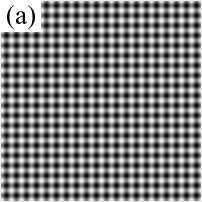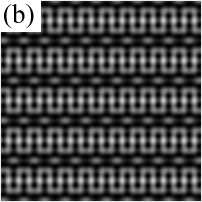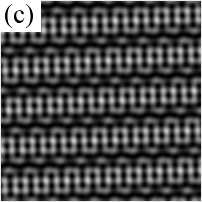|
These are examples of stationary patterns of a ferromagnetic
insulating film which is driven by out-of-plane parallel pump (i.e., the
static magnetic field is perpendicular to the film plane and the magnetic
field of a microwave is parallel to the static field).
The images are synthetic photographs generated on the computer.
They simulate real photographs where Faraday rotation is
used to visualize the patterns. Fig. (a) is a square pattern
built by two standing waves. Fig. (b) and (c) are built up by three
standing waves forming a periodic pattern and a quasi-periodic one,
respectively. These patterns are in general not stationary. The dynamics
switches between them, a process which is very sensitive on noise. For
more details see Ref.
26. There is also movie (MPEG,
1327Kb) which shows the pattern switching.
|


